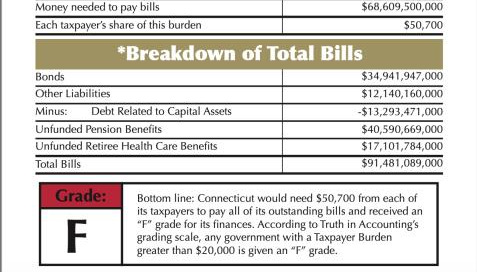Liquidate State Debt Through Spending Reform
The general public is the last group of people to fully understand that the Obama revolution has reached an endpoint. The neo-progressive Democrat Party revolution began with the presidency of Barack Obama in 2009-2017 and ended with President Joe Biden’s catastrophic exit from politics, the longest and unintentionally comic third act in post-modern American politics.
The neo-progressive revolution is rooted in Keynesian economic theory, the central pillar of which is that cautious spending is unnecessary; the sky’s the limit on improvident spending because the national debt is a debt we owe to ourselves. In actual fact, governments approach economic calamity when accumulative expenditures in a nation exceed gross domestic product (GDP), the monetary value of everything produced. State debt occurs when expenditures exceed assets (see chart above). For the last 16 years and more, Connecticut’s ascendant neo-progressive Democrat Party has been engaged in an effort to repeal foundational economic laws. Both businesses and taxpayers are beginning to catch on to the fruitless effort to make the world over anew politically, economically and socially.
Here and there in Connecticut, there are hopeful signs that some in the state will no longer permit themselves to become the victims of pious rhetorical flourishes. Neo-progressive Democrats have become the victims of their own past successes. If you promise voters everything but the kitchen sink – and then thrown in a Marxian kitchen sink, as New York’s leading contestant in the city’s mayoral race has promised to do – you will acquire votes. However, at some point economic laws veto imprudent behavior. Never in the history of the world have people or states been able to spend themselves out of debt. Noticing that spending and debt are causally related is an economically healthy preoccupation. For more than thirty years, Connecticut has not acted on this vital connection, and that is why the state is now nursing an accumulative debt of roughly $68 billion.
Marc Fitch of the Yankee Institute tells us, “Connecticut ranked second to last among all the states for its outstanding debts, which amount to $50,700 per taxpayer, according to an annual accounting of state debt by Truth in Accounting [TIA], a Chicago-based nonprofit organization… In their 2021 annual report, TIA found Connecticut’s total taxpayer burden to be $79.5 billion, amounting to $62,500 per taxpayer, meaning Connecticut has shaved more than $10 billion from its total debt in two years… Much of that is attributable to the fiscal guardrails established by the 2017 budget, which filled Connecticut’s rainy day fund, transferred billions to pay down Connecticut’s pension debts and capped bonding. Connecticut has also been contributing more toward retiree healthcare that, combined with some accounting changes, resulted in a decrease of $4 billion between 2021 and 2022.”
All well and good, but the fiscal guardrails that served to cap deficit spending have now come under attack from Connecticut’s neo-progressives, the most prominent of whom are Senate President Pro Tem Martin Looney and Senate Majority Leader Bob Duff, along with economically (wall-eyed) media “experts” who, like their ideological cousins, think that a long-term reduction in debt can be effected without major structural changes in spending reduction.
Looney is the author of a bill that, had it passed, would have provided tax money to striking Connecticut union workers, people who have been buttering Looney’s reelection bread for dusty decades. Fortunately, Governor Ned Lamont vetoed Looney’s loopy bill, thus incurring the wrath of Connecticut’s far left neo-progressives, some of whom have joined in an effort to challenge Lamont in a Democrat primary. The braggadocio may be little more than a bid for votes from Keynesian fantasists.
Truth be told, neo-progressives cannot abide spending cuts because such cuts deprive them of their coin of the realm. The easiest way to acquire a reelection vote is to buy one. These purchases are made with excess spending, always an expensive proposition born by a distracted middle class, the workhorse of debt reduction. The bill for improvident spending will come due, Democrats hope, at some point in the far, far distant future. Public employee unions have for decades been the most favored beneficiaries of this largess.
State Democrats have now entered a political cul-de-sac. They want to reduce costs through political regulations that do little more than distort what is still amusingly called the free market. But a regulation, like a tariff, is a tax, and Democrats, considering the many crises pressing us down, do not wish to be tagged as enemies of a shrinking middle class. What to do?
You invite the private sector to swallow what amounts to tax increases by hiding the taxes in the costs of their products and services – and then, a stroke of political genius, pretend to regulate those costs. This is what the head autocrat of Connecticut’s Public Utilities Regulatory Authority (PURA), the resourceful Marisa Gillett, is in the process of doing, cheered on by Lamont, deeply concerned with the cost of living in the state over which he presides, labeled by TIA as a tax and regulatory “sinkhole state.”
People -- not including paid economic “experts,” flighty academics and cul de sac neo-progressive reactionaries – are slowly catching on to the fraud for reasons stated long ago by Abe Lincoln: “You can fool some of the people all of the time, and all of the people some of the time. But you can’t fool all of the people all of the time.”
In both murder and politics, the truth will out.



